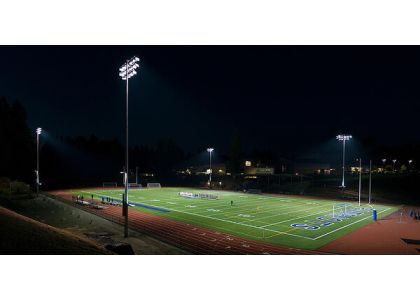
Facility managers at schools, municipalities, and sports clubs are faced with a wide set of challenges. Maintaining several properties, operating on a paper thin budget, and having enough time to get to each task are just a few. While LED sports field lighting might not solve all of your problems, it will go a long way towards improving your sports facilities, reducing your energy consumption and spend, and cutting considerable amounts of time and money from your maintenance budget. Below we present the benefits of LED sports lighting:
Reduction in Energy Spend
What does that really mean? We've compiled tangible numbers to help you decide if LED lights are right for you. Let’s say you have 100 fixtures that you run 100 days a year for six hours at a time. Your cost of electricity is .12 kw/h. Savings for these lights would be $5,400.00 per year. Of course, if your hours of use or cost of electricity are higher, the amount of savings would increase.
Cut Down on Your Maintenance Spend
A lot of facility managers are concerned about the ongoing cost of maintaining their current metal halide or high pressure sodium lighting. Lasting around 20,000 hours, and in many cases much less, getting rid of this maintenance burden becomes a major reason they are looking to replace old field lights with LED.
But let’s look at the behavior of a metal halide light over its lifetime. A metal halide suffers significant lumen degradation quickly. It is not uncommon for a metal halide to lose half of its initial lumens within the first 7,500 hours of life or half-life of the bulb. So even though the lights are still “on," the lighting on the field is dim and should be replaced. This makes maintaining sports field lighting a chore. And it’s not cheap! These fixtures are mounted high, as much as 100 feet in the air, so bringing in equipment and man power is an expensive proposition.
Obtain Higher Quality Lighting Performance
With LED lighting, it is rare for the CRI (color rendering index) to be below 70. This is compared to HPS, whose score is less than 30. What does this mean for the playing field? It’s simple, the LED lights with the higher CRI make everything appear sharper and brighter. The players on the field have a better experience because they can see the ball, and the fans in the stands can see the game. Colors appear as they should and are not discolored by the light source itself.
Every application has its own set of advantages as a result of LED lighting. One of the biggest for sports field lighting is dimming (or in this case, “brightening”) and instant on and off.
Let’s consider these two scenarios:
Scenario One: Your sports field is equipped with 1,000 watt metal halide lamps. The high school football team is taking on their district rival on a Friday night. It’s early fall so the sun isn’t setting too early yet but it will be down by the second quarter. To get the HID lamps fully warmed up, you’ll need to turn them on well before the game starts, and once they are on, they’ll be at full blast the entire time, even when the sun is still shining.
Scenario Two: Same situation as above, but this time you don’t need to turn your lights on until game time because LED lighting has no warm up time. Additionally, once the lights are on, you can program them to gradually get brighter as the sky gets darker, saving as much energy as possible.
The preferred choice is clear. Not only do metal halide lights use more energy to operate and have a much shorter lifespan than LED, you’re inevitably going to have to have them running more often and for a longer amount of time.
LED has three primary advantages: reduction in energy consumed, reduced maintenance cost, and significantly better lighting performance (dimming, on/off, etc.). LED vastly improves the quality of your sport fields and arenas. Not only do they create a higher standard in your facility, but they reduce the costs you are spending to light your areas on the back end as well.